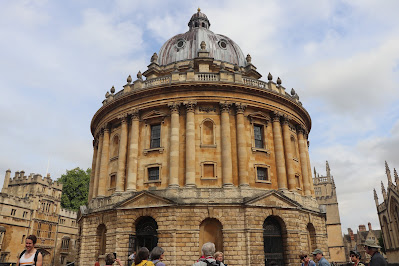 |
| Titanic museum from the deck of the Nomadic |
We started our day at the Titanic Belfast Museum. While we
waited for our time slot in the museum, we toured the oldest white star line
ship, the Nomadic,
which served as a tender to the Titanic in Cherbourg France. Just like in the
Titanic, there were obvious class distinctions between 1st, 2nd
and 3rd class.
 |
| Launching the Titanic |
The Titanic museum started by telling the story of Belfast,
an industrial city for linen, machinery, stoves and shipbuilding. Ships have
been built here since 1600, and over 200 were built the year the Titanic
sailed. The museum gives you a sense of the infrastructure needed to build this
new class of ships. The museum is sited where the ship was built. After
launching the ship, the innards were built and furnished with those clear
distinctions of class. Relatively new to ships was the Merconi telegraph which
had a range of 1000 miles, just enough range to maintain communication throughout
the voyage. We all know the story of hitting an iceberg and quickly sinking. Two
boards of inquiry were created one in the UK and one in the US. A key
conclusion was the ship was traveling too fast for the conditions. The recommendations
made from the inquiry are still in place today: Enough lifeboats for everyone
aboard, a mandatory briefing on safety procedures, and radio communications
constantly manned. This museum was very crowded and has none of the remains
from the ship, but it provides a thorough background on the town, the ship, and
even the rediscovery of the ship from the bottom of the ocean.
 |
| Mural on British side |
In the afternoon, we did the black taxi tour of the
Troubles between the
Catholic Irish nationalists and the British Protestants. Even today, the city
is quite segregated with many Peace Walls separating the neighborhoods. We
visited the 2 ½ mile section of wall which has 4 gates that are opened each day
and closed each night. Our cab driver was Catholic and pointed out that most
children won’t meet a protestant until their first job or at university. The
worst case was a playground with a wall between the two communities. The
troubles began just after the Civil rights movement in the states. The
Catholics felt discrimination in terms of housing and jobs, similar to blacks
in the US. But the truth may be more subtle. Northern Ireland did not have one
person – one vote, it was one household owner – one vote. If you rented, you
couldn’t vote. Most of the working class couldn’t vote. This was changed in 1970s
but too late to avoid the violence of the troubles. The troubles began with the
burning of Catholic homes on Bombay Street. Each side of the wall has murals
and memorials to the people who perished in the troubles. The British side had
flags and pennants leaving no doubt that they were British. The Republican side
was not as clear, but had memorials to the IRA. We paid a visit to Christ the
Redeemer Church where the troubles were formally ended. Built just after the
potato famine, the church is richly decorated with mosaics.
 |
| The "Peace Wall" today |
In the evening we heard from two men who were on opposing
sides, and still can’t agree on the end point for Northern Ireland, but often
engage in front of audiences to encourage dialog.
Michael
is a Catholic Republican. He spent 16 years in prison for murdering a British
soldier. The US Civil rights movement started my thoughts. What would you do if
the Russians invaded? That's how I felt about the British, especially when 13
were shot for asking for their rights.
Robert is British. He spent 17 years in prison for his actions with the Ulster
Volunteer Force. I don't want people to use guns to settle differences, use
debate. Be true to yourself, but don't use violence.
We're friends with different viewpoints and different end points. Though we
both think Brexit was a mistake, but for different reasons mine was economics,
Michael felt Brexit might lead to a united Ireland.
We’re trying to get young people to meet other people and understand their
viewpoint. Over 90% still are educated separately from the other. Most don't
meet the other until a job or university. What were women’s role during
the troubles? 24000 IRA prisoners about 2000 women. Very few British women
prisoners.
Vote was based on owning a household, renters couldn't vote in the mid 70s. The
laws at the time undermined the Catholics, but also any working-class person.
Class had a lot to do with what happened.
The people who live near the wall remember what happened before, they still
feel more secure, “the walls should be removed, but not now”.
We need to encourage the next generation to dialog, rather than violence.
 |
| Memorial on Irish National side |
The
signs of hope are like our taxi driver's 23 year old Catholic daughter, who
married a British protestant.






























